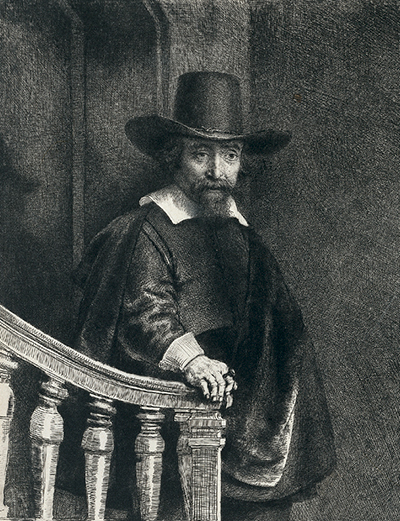This print derives from a truly accomplished etching which came about after Rembrandt has been working with this medium for around two decades. The gentleman pictured was well known to him and had an involvement in the arts himself.
Ephraim Bonus was a Portuguese Jewish doctor in the 1640s who was sufficiently wealthy to help support local artists. He financed a printing house, for example, which is, no doubt, how he came to know Rembrandt. We do know that the artist initially produced a fast sketch in oils before transferring it into an etching for the purposes of printing. Whilst he was entirely comfortable in that process by now, it was rare for him to work from an oil painting. The model himself stands confidently at the bottom of his stairs, with a hand draped over the banisters. He is smartly dressed but appears entirely approachable at the same time. It is likely that he was particularly popular with the likes of Rembrandt because of his generous support for many struggling artists in that local area.
Rembrandt would increase the variation in tone between each state of this etching, slowly incorporating more detail and a greater contrast between the background and the various parts of the foreground. You will see, for example, some regions which are particularly dark, almost black, such as Ephraim Bonus's hat and clothing, whilst other parts use variations of grey for a more subtle finish. The overall atmosphere portrays this figure as serious but professional and certainly respected within his local community, just as he was.
There are several prints from this etching in existence today, with the most famous one remaining in the collection of the Cincinnati Art Museum in the United States. The proliferation of prints from Rembrandt's career has allowed many more institutions to get hold of some of his work when otherwise the items would be too expensive or scarce. It is quite possible that someone locally had collected this item before later donating it to the institution so that more members of the public would be able to enjoy it themselves. The prints themselves are now fairly valuable, though their precise worth is dictated by how many other versions of the print were produced, and how many still exist in good condition today, which is often very few. You will find many more interesting items in the collection of the Cincinnati Art Museum, with some of the highlights including An Artist Studying from Nature by Claude Lorrain, Samson and Delilah by Peter Paul Rubens, Rocks at Belle-Île, Port-Domois by Claude Monet and also The Fall of Tequendama, Near Bogotá, New Granada by Frederic Edwin Church, which underlines the variety in their collection.




